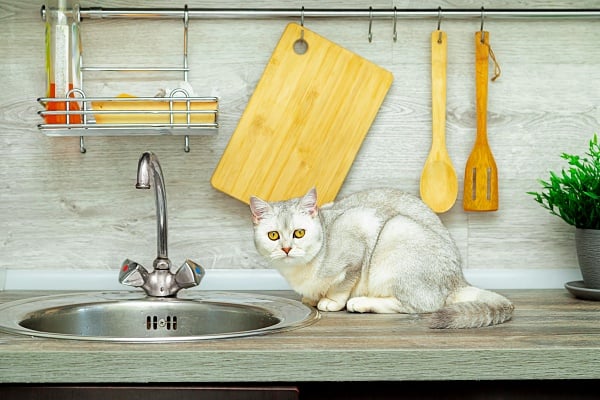Do you struggle to stop your cat from jumping on the kitchen counter? You are not alone. For many people, including those who love their cats and consider them part of the family, countertops in the kitchen are places they would like to see free of cats.
The problem is, cats love to climb and jump. Add their famous curiosity to the equation and you will find yourself in a fight you cannot win. Or can you?

Table of Contents
Why your cat shouldn’t be on your kitchen counter
Cats can transmit diseases to us humans. Yes, we all feel our four legged fur babies could never hurt us, but there are diseases and parasites that can be transmitted to us. They don’t mean to do it, it can happen. This is why keeping your cats off the surfaces where you prepare your meals is important to keep you healthy.
The following contains affiliate links. As an Amazon Associate I earn from qualifying purchases. This is used for keeping the blog up and running smoothly. Please know this does not change the price you see on Amazon. Thank you for your help and support of Pet-Happy!
If you don’t have Amazon Prime, we highly recommend trying it. The biggest benefit is free shipping. Yes, free ! You can also get your orders in 1,2, and even same day along with 2 hour grocery delivery. One of our favorites is the free movies and TV shows on Amazon Prime. There are so many more benefits. To find out yourself, you can try Amazon Prime free for 30 days. If you have a Kindle and love reading like we do, you can also try Kindle Unlimited free for 30 days.
1. Use a cat repellent
The best way to keep your cat off the counter is to let the counter or environment provide the deterrent. Your cat usually climbs up there when you aren’t around so a great way is to use a repellent. It’s way better than squirting water or yelling at your cat. Firstly and most importantly, because you don’t want your cat to be afraid of you. Secondarily, repellents have two critical features. (1) It is consistent, which will make your cat learn faster. (2) It works when you aren’t around so your cat won’t associate you with the deterrent.
Not all cat repellents work the same way or have the same effectiveness. Here is a list of the most successful repellents to keep cats off counters:


- Motion-activated pet deterrents. sssCat is a small battery-operated device that detects motion and releases an air burst whenever a cat approaches. It’s not harmful, but it is scary for cats. The best part, sssCat provides consistency, working every single time your cat jumps on the counter. Pretty soon, he or she will not even try to approach it. For more information, please see our video of our review of sssCat. You can buy sssCat here.
- Empty aluminum cans. By placing a bunch of empty aluminum cans on the counter, your kitty will scatter them all over when they jump onto the kitchen counter. This will startle them with lots of noise they make and they’ll think twice before jumping on the counter. Make sure to wash them out well so they only make noise and not make a mess. This is usually quite effective and one “crash” into the cans usually works. Make sure to put them on all the kitchen counters.
- Aluminum foil. This is another thing that cats do not like to step on because walking on it creates a rustling sound that bothers them. The hardest part is placing the foil on a spot on which the cat will jump and then keeping it in place (a small strip of Scotch tape will be useful). Unlike double-sided tape, it’s much easier to set up and remove when not needed.
- Citrus fruit peels. Do you eat lemons and oranges? Their skins are excellent cat deterrents. Unfortunately, citrus peels dry quickly and become ineffective, usually within a few hours. If the above ideas don’t work, you might try this one.
- Electric mats. If all else fails, this is a sure fire way to keep your cat off the counter. A mat that gives a static pulse when your cat lands on it will most certainly keep them off for good. The PetSafe ScatMat comes in multiple different sizes to fit your counters. It’s battery powered and keeps track of how many times your cat has stepped on it. It has 3 levels which allows you to start with the lowest and move up if your cat is very determined. Best of all, once they’ve learned not to jump on the counters, you can use them to keep them off other places such as furniture or even enter certain rooms. For more information, please see our ScatMat review.

2. Distract your cat
Now that you’ve deterred your cat, it’s time to make things better for them. No one likes being scared. So here’s what you can do.
As soon as you notice that your cat is approaching the counter, distract him or her. You can throw a toy such as these inexpensive catnip mice in the opposite direction, or you may call your cat to you.
Pet them, talk to them, give them a treat, or play with them. This way, you reward them for being such a good kitty. We strongly believe in positive reinforcement for a happy pet.
You may also try a clicker. This training will help you reward your cat for good behavior and eliminate the need to carry treats with you all the time. Call your cat to you; if they come, click the clicker, which gives you time to get the treat. You can find more information about clicker training here.
3. Provide an alternative to the counter
Cats love heights, as we already mentioned above. Climbing is a necessity which roots in your cat’s instincts, and, if you think the kitchen worktops are not an option, you should think of another place that serves this purpose.
How about a cat tree in the kitchen? Place it in the kitchen so your cat can see what you are doing on the counter but not where he could use it as a stepping stone to the counter. It may not keep your cat off the counter entirely, but it will make things a lot easier and less stressful for your cat. To encourage their use, place a treat, kibble, or their favorite toys on the tree to positively reward them for their good behavior.
Other options might include installing shelves appropriate to your cat’s weight or a window perch in places where your cat spends their time. Our house has all three. Window sills are wide enough for cats to jump on them. We have several cat trees in different locations. We also have shelves that form passages from one cat tree to another without them having to descend to the floor. Our cats absolutely love the different options.
4. Stop rewarding your cat jumping on the counter
Cats usually jump on the counter because they know there must be something good there. In most cases, it’s food. Your cat may be interested in other things such as an outside view, running tap water, a plant on the counter, and many times, it’s because you are there.
Try putting away food instead of keeping it on the counter. Storing your food and supplies in the refrigerator or a cupboard. We often keep part of our food in the microwave (while it’s turned off). The microwave has solid doors that even the most capable cat is not able to open.
Additionally, some people enjoy how their cat plays with the tap water but get mad if the cat jumps on the counter at other times. They only know that you let them play with the water from the tap so you’ve taught them that’s okay behavior. They can’t tell that there is an okay time and not okay time to do that.

Whatever the reason, simple observations may show you what your cat is doing up there. Once you know what is that he’s interested in, you should be able to think of a solution. Sooner or later, if a cat jumps on the counter and does not find what he’s after, he’ll stop doing it.
The last piece of advice is spending some quality time with your cat and making his surroundings more appealing to him.
Quite often, cats misbehave because of pure boredom. We, pet owners, love to note at these times that cats do such and such because they are cats, and cats do whatever they please. That is true, but we’d like to view this statement differently.
If you take away things your cat likes, he or she will find alternative things to do. The bad part is, you may not like these new things. Maybe it’s time to find something that you and your cat both like and do it. This, in turn, will keep your cats off the kitchen counters without too much hassle.
Like all training, consistency is the key. Your cat will be happier as they know what is positive behavior. And, your counters will be cat free.
Does your cat misbehave in other ways, too? See our list of most common cat behavior problems and their solutions.
